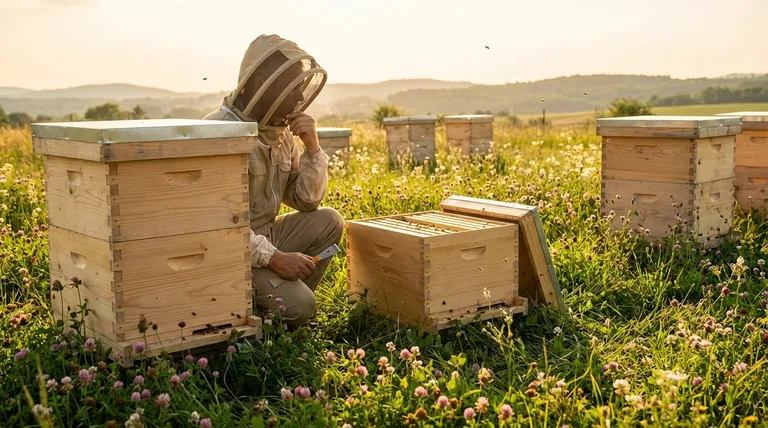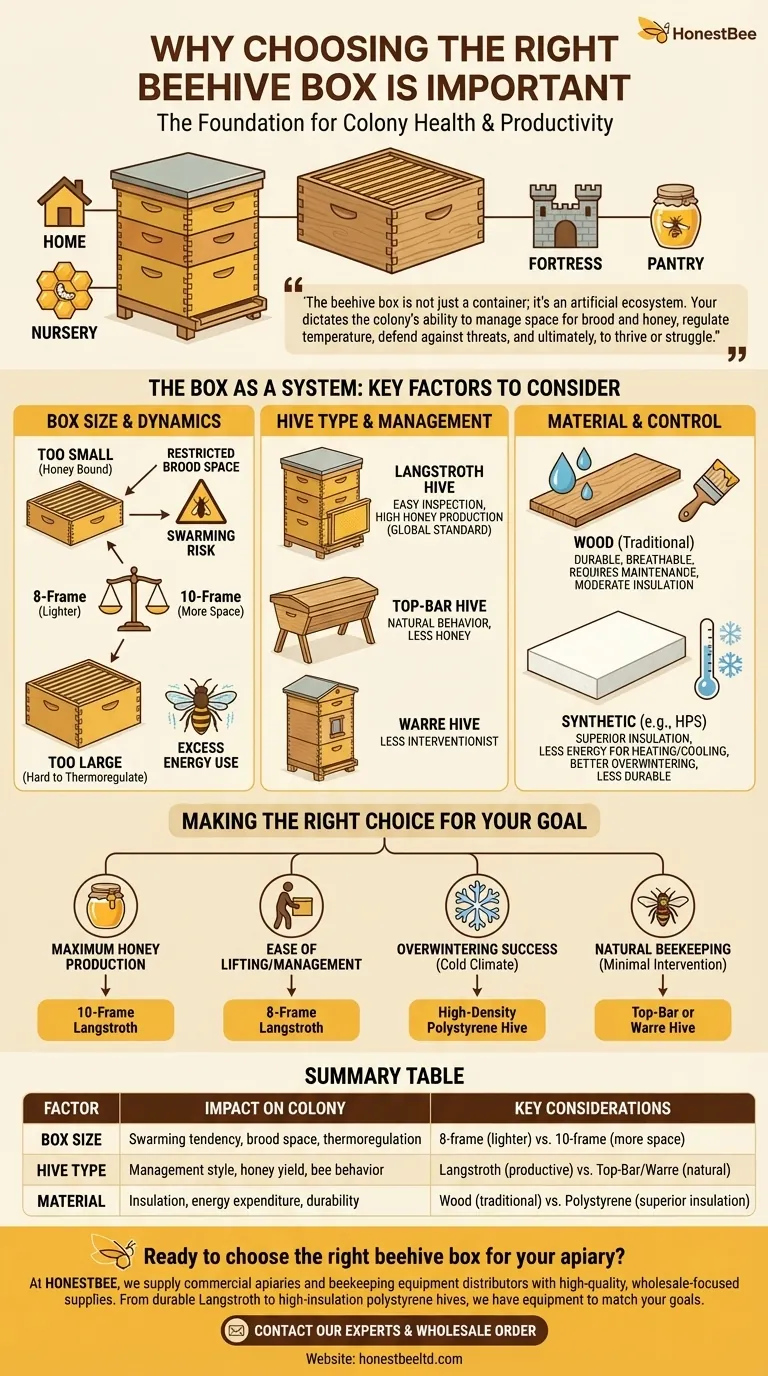Choosing the right beehive box is one of the most foundational decisions a beekeeper can make. It is far more than a simple container; it is the colony's home, nursery, fortress, and pantry all in one. The box's design, size, and material directly impact the colony's ability to regulate its environment, raise young, store food, and defend itself, which in turn dictates its overall health and productivity.
The beehive box is not just a container; it's an artificial ecosystem. Your choice dictates the colony's ability to manage space for brood and honey, regulate temperature, defend against threats, and ultimately, to thrive or struggle.

The Box as a System: Key Factors to Consider
Understanding the beehive as an integrated system is crucial. Each component of your choice has a direct and cascading effect on the colony living inside.
Box Size and Colony Dynamics
The internal volume of the hive directly influences the queen's laying patterns and the colony's tendency to swarm.
A box that is too small will quickly become "honey bound," where cells needed for raising brood are filled with nectar. This restricts the queen's ability to lay, slows population growth, and is a primary trigger for the colony to swarm (where the queen and half the bees leave to find a new home).
Conversely, a box that is too large for a small colony is difficult to defend and thermoregulate. The bees must expend excess energy to keep the brood nest warm, diverting resources from foraging and expansion.
Hive Type and Management Style
Different hive types cater to different beekeeping philosophies and goals. The most common is the Langstroth hive, known for its modular, stackable boxes and removable frames. This design is the global standard for honey production because it allows for easy inspection and manipulation.
Other styles, like Top-Bar or Warre hives, are designed for a more "natural," less interventionist approach. While these often produce less honey, they appeal to beekeepers focused on pollination or observing more natural bee behavior.
Material and Environmental Control
The material of the hive is its interface with the outside world, primarily impacting insulation.
Wood is the traditional material. It's durable, breathable, and sustainable. However, it is heavy and provides only moderate insulation, requiring more effort from the bees to maintain temperature in very hot or cold climates.
High-density polystyrene (HPS) and other synthetic hives offer superior insulation. This means bees expend less energy on heating in the winter and cooling in the summer, which can lead to stronger colonies and better overwintering success.
Understanding the Trade-offs
There is no single "best" beehive box; there are only trade-offs that align with your specific goals, physical ability, and local climate.
The 8-Frame vs. 10-Frame Dilemma
This is a classic debate for Langstroth users. A 10-frame box is the commercial standard, offering more space for brood and honey. However, a deep 10-frame box full of honey can weigh over 80 pounds (36 kg), making it difficult for many people to lift.
An 8-frame box is narrower and significantly lighter, with a full deep box weighing closer to 60 pounds (27 kg). This makes it far more manageable, though it offers less space per box, potentially requiring you to add new boxes more frequently.
Wood vs. Synthetic Materials
Wood is the aesthetic and traditional choice, but it requires regular maintenance like painting to protect it from the elements. Its insulation value is a known baseline that works in most climates.
Synthetics like HPS provide exceptional insulation, which can be a game-changer in harsh climates. However, they are less durable against physical damage from hive tools and may be more susceptible to pests like wax moths if the colony is weak.
Productivity vs. Natural Behavior
The highly manageable Langstroth hive is optimized for honey production and frequent inspections. This is efficient but also more disruptive to the colony's natural rhythms.
Hives like the Top-Bar are managed with far less intrusion. This is less stressful for the bees but also means lower honey yields and less direct control over colony health issues. Your choice reflects your primary reason for keeping bees.
Making the Right Choice for Your Goal
Your ideal beehive box depends entirely on your primary objectives.
- If your primary focus is maximum honey production: A 10-frame Langstroth hive is the proven industry standard designed for this purpose.
- If your primary focus is ease of lifting and management: An 8-frame Langstroth system is an excellent choice that reduces physical strain without sacrificing the benefits of a modular hive.
- If your primary focus is overwintering success in a cold climate: A high-density polystyrene hive offers superior insulation that can significantly improve a colony's survival chances.
- If your primary focus is natural beekeeping with minimal intervention: A Top-Bar or Warre hive better aligns with a philosophy of letting the bees manage their own space.
By aligning your equipment choice with your beekeeping philosophy and physical capabilities, you set the stage for a healthy, productive, and rewarding experience.
Summary Table:
| Factor | Impact on Colony | Key Considerations |
|---|---|---|
| Box Size | Swarming tendency, brood space, thermoregulation | 8-frame (lighter) vs. 10-frame (more space) |
| Hive Type | Management style, honey yield, bee behavior | Langstroth (productive) vs. Top-Bar/Warre (natural) |
| Material | Insulation, energy expenditure, durability | Wood (traditional) vs. Polystyrene (superior insulation) |
Ready to choose the right beehive box for your apiary?
At HONESTBEE, we supply commercial apiaries and beekeeping equipment distributors with the highest-quality, wholesale-focused beekeeping supplies. Whether you need durable 8-frame or 10-frame Langstroth boxes, or high-insulation polystyrene hives for superior overwintering, we have the equipment to match your goals for health, productivity, and ease of management.
Contact our experts today to discuss your specific needs and place a wholesale order.
Visual Guide

Related Products
- Langstroth Bee Hives Bee Keeping Box for Beginners Beekeeping
- Australian Langstroth Beehive Boxes for Beekeeping Wholesales
- Langstroth Honey Bee Box Hive Boxes for Different Depths
- Professional Insulated Plastic Bee Hives
- Long Langstroth Style Horizontal Top Bar Hive for Wholesale
People Also Ask
- How does the ease of access differ between 8-frame and 10-frame hives? Choose the Right Hive for Your Body
- What are the key features of the Langstroth beehive? A Guide to the Standard for Modern Beekeeping
- Should a beginner try a different type of hive? Start with a Langstroth for a solid foundation.
- How does the orientation of the hive sides benefit comb construction? Ensure Straight, Movable Combs for Easier Hive Management
- What is the best type of bee hive for beginners? Start with the Proven Langstroth Standard



















